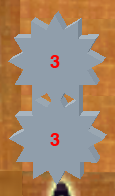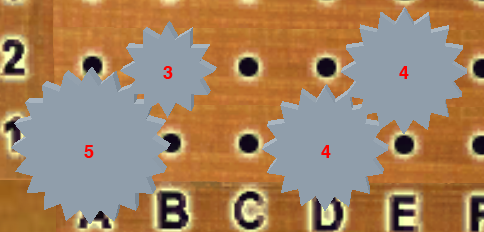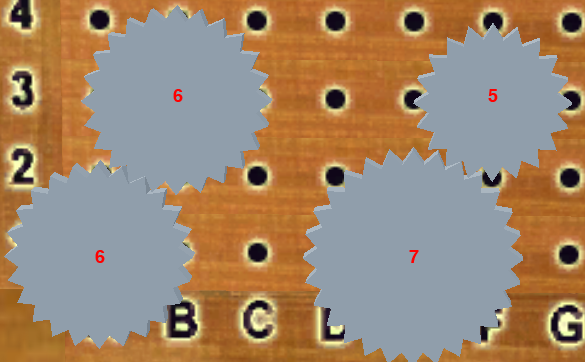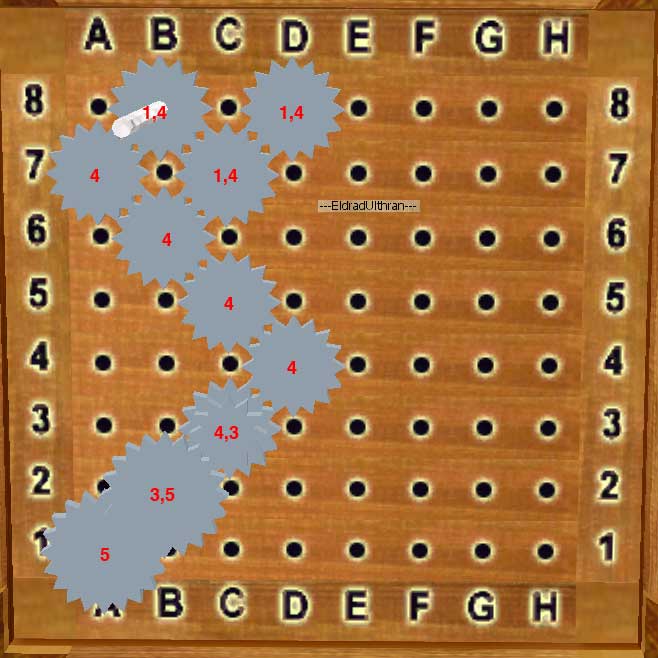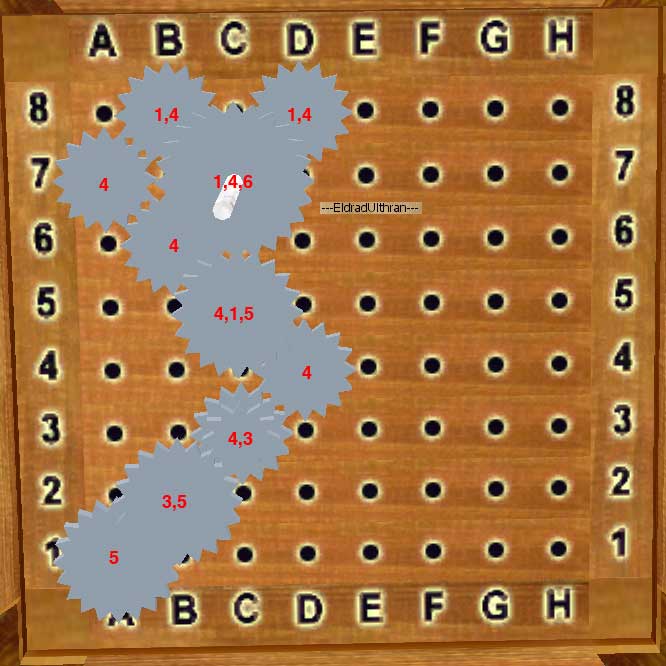Basics
The basics of making a gearbox are you start out at 'A1' and need to move with a certain ratio to the output which is row 8 at particular letters. You can have up to three outputs. Ratios are written as percentages and you start out with a ratio of 100 and can increase or decrease it. Gear trains are generally notated in a form like: "(5/3) * (5/3) * (5/3) * (4/7)" The numbers range from 3 to 7 and represent gears of that size. The '/' means the two gears mesh together and the '*' mean the two gears share the same shaft. In most real gearboxes you be sticking in a bunch of (3/3/3...)'s and/or (4/4/4...)'s in between some of the meshing sets of gears. The things separated by '*'s can be rearranged in any order.There are seven different pairs of gears which can mesh with each other correctly. It's useful to be familiar with what space they take up on a table so I have shown them bellow.
One Steps
3/3 is the only pair which can mesh when the gears are next to each other. You will often use this to move small distances.
Diagonals
5/3 (or 3/5) is commonly used as a cheap way of causing large change in your ratio. 4/4 is the generally most useful way of moving over distances as it's cheap and moves twice as much as the one step.
Two Steps
6/5 (or 5/6) is generally used to make small changes to the ratio. 7/4 (or 4/7) is very expensive because the 7 is a large gear costing six times that of a medium.
Knight's Moves
6/6 is very rarely used because it costs two medium gears where as the 4/4 only costs two small. 7/5 (or 7/5) again very expensive due to the use of a 7.
Example of Making a Gearbox
This is a quick example of how to make a gear box. In this example we'll be making a gearbox 3 output gear box of A250-A300, B200-B275, D223-D270.
Chose Your Ratios
The first step is to chose what ratios you want to use. There are a couple lists of gear box ratios on the wiki personally I like [this one]?. Copy all the possible ratios for each output into a text file like so:A250-300
- 250 9 (6/5/3) * (5/7/4)
- 252 10 (6/5) * (6/5) * (7/4)
- 265 9 (5/3) * (5/3) * (5/3) * (4/7)
- 267 9 (6/5/3) * (4/7/5/3)
- 268 9 (5/3) * (5/3) * (5/3) * (5/6) * (5/6) * (5/6)
- 278 2 (5/3) * (5/3)
- 280 9 (6/5/3) * (7/5)
- 288 6 (6/5/3) * (6/5) * (6/5)
- 292 7 (5/3) * (7/4)
B200-275
- 200 2 (6/5/3)
- 207 8 (6/5) * (6/5) * (6/5) * (6/5)
- 208 8 (5/3) * (5/7/4)
- 210 8 (6/5) * (7/4)
- 222 8 (5/3) * (4/7/5/3)
- 229 10 (6/5/3) * (6/5/3) * (4/7)
- 231 4 (5/3) * (5/3) * (5/6)
- 233 8 (5/3) * (7/5)
- 238 10 (5/3) * (6/5/3) * (5/7)
- 240 4 (6/5/3) * (6/5)
- 243 9 (5/3) * (5/6) * (7/4)
- 249 10 (6/5) * (6/5) * (6/5) * (6/5) * (6/5)
- 250 9 (6/5/3) * (5/7/4)
- 252 10 (6/5) * (6/5) * (7/4)
- 265 9 (5/3) * (5/3) * (5/3) * (4/7)
- 267 9 (6/5/3) * (4/7/5/3)
- 268 9 (5/3) * (5/3) * (5/3) * (5/6) * (5/6) * (5/6)
D223-270
- 229 10 (6/5/3) * (6/5/3) * (4/7)
- 231 4 (5/3) * (5/3) * (5/6)
- 233 8 (5/3) * (7/5)
- 238 10 (5/3) * (6/5/3) * (5/7)
- 240 4 (6/5/3) * (6/5)
- 243 9 (5/3) * (5/6) * (7/4)
- 249 10 (6/5) * (6/5) * (6/5) * (6/5) * (6/5)
- 250 9 (6/5/3) * (5/7/4)
- 252 10 (6/5) * (6/5) * (7/4)
- 265 9 (5/3) * (5/3) * (5/3) * (4/7)
- 267 9 (6/5/3) * (4/7/5/3)
- 268 9 (5/3) * (5/3) * (5/3) * (5/6) * (5/6) * (5/6)
Now you want to make the cheapest gearbox generally you'll just look at the number of medium gears required because they're significantly more expensive than small gears. First just quickly go through the lists and find the cheapest ratio for each output in this case it's 2 for A, 2 for B and 4 for D. 2+2+4=8 so you know you'll be able to make something which costs at most 8 medium gears so now you can eliminate all the ratios which cost 8 or more medium gears:
A250-300
- 278 2 (5/3) * (5/3)
- 288 6 (6/5/3) * (6/5) * (6/5)
- 292 7 (5/3) * (7/4)
B200-275
- 200 2 (6/5/3)
- 231 4 (5/3) * (5/3) * (5/6)
- 240 4 (6/5/3) * (6/5)
D223-270
- 231 4 (5/3) * (5/3) * (5/6)
- 240 4 (6/5/3) * (6/5)
So now that we're looking at a much shorter list we can see that 278 which is (5/3) * (5/3) and 231 which is (5/3) * (5/3) * (5/6) both share "(5/3) * (5/3)" and 231 meets the requirements for both the B and D spots. So if we use A278, B231 and D231 we can make a gearbox using only 4 medium gears. What your looking for in overlapping is places where the starting at a '(' reading left to right the numbers are the same... so for example "(5/3) * (6/5)" and "(6/5)" overlap nicely and even "(5/3)" and "(5/6)" overlap by 1 medium gear, but "(6/5/3)" and "(5/3)" don't over lap.
And now we've chosen our ratios so the first step is done:
A250-300
- 278 2 (5/3) * (5/3)
B200-275
- 231 4 (5/3) * (5/3) * (5/6)
D223-270
- 231 4 (5/3) * (5/3) * (5/6)
Putting the Box Together
To start out you want to do the (5/3) * (5/3) because that's getting used by all three of your outputs so you might as well get it out of the way. Now the notation 5/3 means that you have a '5' gear meshing with a '3' gear like so:And the '*' means you have the two gears on the same shaft so they're not meshing. So (5/3) * (5/3) looks like this, note that there is a "spacer" or a '1' under the last 3 to get it up to the same height as the 5.
Now we're going to want to make a long train of 4/4's to get up near the outputs. So let's go back and replace the spacer under the last 3 with a 4 (you have to remove both the 3 and the 1 then add 4 and put the 3 back on). Then add a whole bunch of 4's all meshing together (note that 4/4 does not change the ratio at all, nor does 3/3 or 6/6).
We know we want B and D both to be the same outputs so let's go ahead and skip ahead to connect them to each other. Note that we don't want them to connect to the train of 4 gears going up towards A because they're going to be different from that so we must put a spacer underneath each of them.
Now let's add in the 5/6 connecting in B and D. Again we're going to need to add a spacer under the 5 to get it to reach the 6.
Finally we need to actually reach A8 so we're going to use a 3/3 connection, but we can't put it at the same level as the 4 on B8 because those would jam. So we need to add a spacer underneath the first 3 and two spacers under the second giving us this final gear box:
The result is a gearbox A278 B231 D231 costing 12 Small Gears and 4 Medium gears. A small challenge for the reader it is possible to make a gearbox with the same outputs using only 10 Small Gears and 4 Medium Gears.
